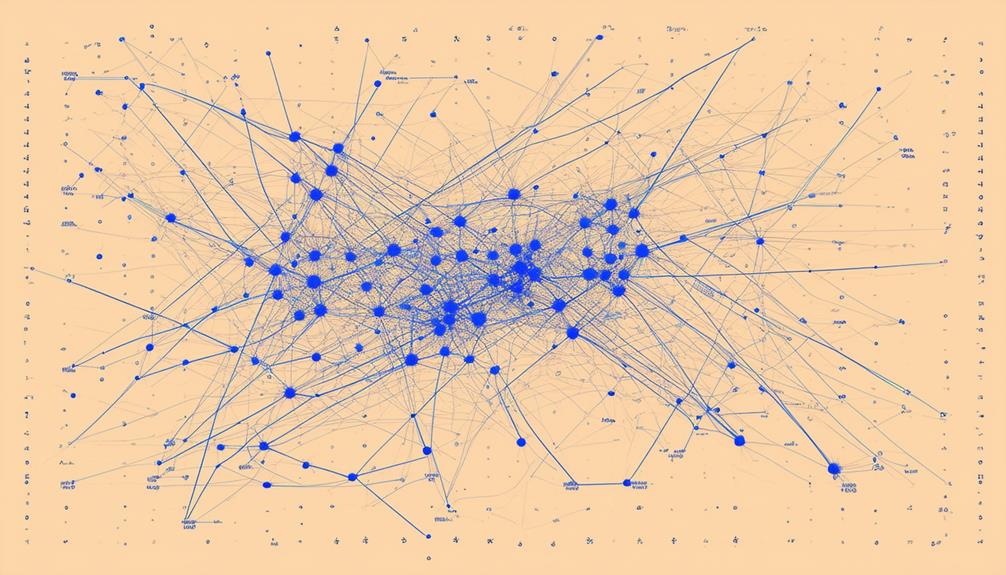I rely on machine learning models to detect network security anomalies with precision. As tech giants like Amazon invest in advanced techniques, I've noticed significant improvements. Deep learning models excel at pattern recognition within network data, enhancing detection speed and accuracy. Techniques like Variational Autoencoders, Generative Adversarial Networks, and Deep Support Vector Data Description then stand out. These robust models allow for proactive defense and adapt to evolving threats, enhancing overall network security.
Key Takeaways
- Isolation Forest and Local Outlier Factor (LOF) are effective techniques for identifying unusual network behavior without prior knowledge of anomalies.
- Deep learning models like Autoencoders and Generative Adversarial Networks (GANs) enhance anomaly detection by learning normal behavior and reconstructing data accurately.
- Support Vector Machines (SVM) are versatile machine learning algorithms that can accurately detect anomalies in complex network datasets by maximizing the margin between data points.
- Unsupervised learning methods like DBSCAN and Hierarchical Clustering identify hidden patterns in network data, enabling the detection of unknown threats.
- Clustering models like k-Means and k-Nearest Neighbors (kNN) group similar network behavior patterns, helping to discover outliers and anomalies effectively.
Evolution of Anomaly Detection
Anomaly detection in network security has transformed notably over the years, evolving from traditional rule-based methods to advanced machine learning models that offer higher accuracy and speed in detecting network anomalies. These advanced techniques now excel in intricate pattern recognition within network data.
Machine learning models now offer higher precision in detecting network anomalies compared to manual rule configurations. Advanced anomaly detection models can manage larger volumes of network data in real-time, enabling quicker threat detection and response. This marks a noteworthy improvement in network security.
Deep learning algorithms, in particular, have enhanced the evolution of anomaly detection techniques. These algorithms are better suited for identifying more intricate patterns in network data, further reducing the risk of undetected threats.
Proactive security measures have emerged as a result of the evolution of anomaly detection, helping organizations stay ahead of cyber threats and vulnerabilities. This thorough and responsive approach has notably enhanced network security.
How AI Models Enhance Detection
In anomaly detection, machine learning models take detection to the next level by leveraging advanced algorithms like deep learning and neural networks. These models can process vast amounts of network data in real-time, accurately flagging anomalies with speed.
Enhanced Detection Speed
By leveraging the prowess of AI, I can tap into the incredible speed AI models bring to detecting network security anomalies, swiftly analyzing vast amounts of data in real-time to promptly identify potential threats. Traditional methods pale in comparison, as AI-enhanced detection tackles the deluge of network data with ease, rapidly processing and analyzing it for immediate anomaly identification.
The accelerated detection capabilities of machine learning models allow for rapid response times. These models excel in swiftly detecting anomalies, enabling me to take swift action against potential threats before they escalate. Enhanced detection speed means network security breaches can be contained before they wreak havoc.
AI algorithms seamlessly integrate into the data analysis process, remarkably increasing the efficiency of anomaly detection. Data can now be analyzed in real-time, ensuring that even the most complex anomalies are quickly identified and addressed.
Complex Pattern Recognition
Offering unparalleled capabilities for complex pattern recognition, I can now tap into the power of AI models to detect subtle anomalies in network security, identifying even the most sophisticated cyber threats through advanced deep learning techniques.
This advanced recognition ability allows me to identify potential security breaches that traditional methods might overlook.
With AI models, I can analyze vast amounts of data to detect anomalies that indicate evolving attack patterns. This proactive approach enhances the overall security posture of networks by adapting to newly emerging threats.
Key Factors in AI-powered Anomaly Detection:
- Deep learning techniques: AI models leverage techniques like autoencoders and GANs to identify deviations from normal network behavior.
- Advanced pattern recognition: AI models excel at detecting subtle anomalies, making them effective in detecting potential security breaches.
- Proactive defense: AI models adapt to evolving attack patterns, ensuring the security posture of networks is consistently enhanced.
Types of Network Anomalies

As I continue to explain the various aspects of network anomaly detection, I find it particularly interesting to explore the ways in which process control techniques, data point analysis, and statistical methods help distinguish and understand network anomalies.
These techniques allow us to elegantly identify and handle anomalies, enhancing the overall effectiveness of network security measures. By combining these approaches, we can better pinpoint and manage discrepancies in network behavior.
Process Control Techniques
I pivot into process control techniques for network security, which primarily involve detecting anomalies like unauthorized access attempts, malware infections, and unusual network traffic patterns. These techniques play an essential role in identifying various types of network anomalies that can pose significant security risks if left undetected.
The following key aspects of process control techniques highlight their effectiveness:
- Network Traffic Analysis: Monitoring network traffic for unusual patterns helps detect anomalies like DDoS attacks, port scanning activities, and data exfiltration attempts.
- Real-Time Detection: Process control techniques enable real-time anomaly detection, enhancing network security by proactively addressing potential risks and vulnerabilities.
- Anomaly Identification: These techniques help identify anomalies such as unusual spikes in data transfer, unauthorized device connections, and abnormal user behavior.
- Vulnerability Mitigation: Process control techniques contribute to preventing security breaches, data leaks, and other cyber threats by rapidly detecting and mitigating anomalies.
Data Point Analysis
Machine learning models greatly enhance data point analysis by identifying various types of network anomalies, including point anomalies, contextual anomalies, and collective anomalies. These distinctions are essential for effective network security, as each type of anomaly demands attentiveness and precise incident response. Understanding the differences between them empowers security professionals to respond accordingly, prioritizing the most important threats.
Anomalies can be categorized as follows:
| Anomaly Type | Description | Example |
|---|---|---|
| point anomalies | Individual data points significantly different from the rest. | High network bandwidth usage during late hours. |
| contextual anomalies | Data points that are abnormal within a specific context or subset. | High bandwidth usage during regular office hours. |
| collective anomalies | A group of data points deviating from the norm together. | Unusually high network traffic during a known vulnerability scan. |
Statistical Methods
In network security anomaly detection, statistical methods are employed to identify types of anomalies rooted in the statistical properties of network data, including point, contextual, and collective anomalies. These methods focus on understanding the statistical behavior of network data to detect deviations that may indicate security threats. Statistical models are critical for this scenario because they allow for the identification of patterns and trends within the data that indicate normal and anomalous behavior.
Here are the key aspects of statistical methods in network security:
- Point Anomalies: These are single instances that deviate from the norm, indicating unusual behavior.
- Contextual Anomalies: These types of anomalies depend on the specific context of the data, considering factors such as time, location, and user behavior.
- Collective Anomalies: These involve a group of data instances deviating collectively from the expected behavior.
- Statistical Foundations: Statistical anomaly detection models are rooted in statistical theories and the analysis of data distributions.
These statistical methods provide a robust framework for identifying and understanding network anomalies, enhancing the security and integrity of network systems. By leveraging the power of statistical analysis, network administrators can proactively detect and mitigate security threats more effectively.
Neutralizing False Positives
False positive alerts in anomaly detection can impair the effectiveness of a security system by generating unnecessary noise and wasting resources. These false alarms can lead to desensitization among security teams, causing them to ignore critical alerts, and ultimately, compromising security. Neutralizing false positives is essential to enhance the efficiency of anomaly detection.
To mitigate false positives, refining the anomaly detection model is necessary. Techniques like threshold adjustment, feature selection, and model tuning can greatly reduce incorrect identifications. Machine learning models, for instance, can adapt and learn to distinguish between true anomalies and false alarms. These advanced models can analyze and process vast data for improved accuracy.
Effective false positive mitigation is important to ensure the reliability of anomaly detection systems. By minimizing false positives, we can optimize resource allocation and ensure prompt responses to genuine security threats.
In this era of digital freedom, robust network security is paramount. Implementing robust machine learning models for anomaly detection is the key to achieving this goal.
Robust Anomaly Detection Systems

To effectively defend against advanced threats, my strong anomaly detection system leverages advanced machine learning models to identify and respond to abnormal network behavior quickly and accurately. These systems play an essential role in preventing security breaches by analyzing immense data in real-time, guaranteeing swift detection and response to potential threats.
The effectiveness of strong anomaly detection systems lies in their ability to adapt to evolving threats and continuously improve their detection capabilities through machine learning algorithms.
Key features of strong anomaly detection systems include:
- Real-time monitoring to rapidly identify and flag anomalies.
- Machine learning algorithms like Isolation Forest and Local Outlier Factor to enhance detection accuracy.
- Scalability to handle vast network data.
- Continuous learning to improve detection capabilities and respond to new threats.
These systems employ techniques like Density-based anomaly detection, Time series analysis, AI-enhanced Detection Systems (IDS), and Support vector machine (SVM) to guarantee strong performance. Additionally, they utilize Clustering-based anomaly detection and artificial neural networks to optimize performance.
Role of Unsupervised Learning
ArXiv summarizes the essential role of unsupervised learning in detecting unknown anomalies in network traffic. This powerful machine learning technique empowers AI models to find patterns in unlabeled data without preseasoned categories.
This means that, unlike traditional methods that rely on labeled data, unsupervised learning models like Isolation Forest and Local Outlier Factor can identify unusual events independent of human intervention.
In network security, anomaly detection is pivotal for identifying unknown threats. By finding patterns in data generated by network behavior, unsupervised learning models efficiently detect breaches or unusual activities without needing pre-defined categories for malicious events.
This allows cybersecurity systems to adapt and respond in real-time, providing robust protection against cyber threats.
In today's digital landscape, unsupervised learning is crucial for network security, ensuring continuous monitoring for unusual activities and unknown anomalies that can evade traditional methods.
Support Vector Machines in Anomaly Detection

Support Vector Machines (SVMs) uniquely excel in distinguishing normal and anomalous patterns within network traffic due to their ability to identify the hyperplane that best separates these data points. This allows SVMs to effectively detect anomalies by maximizing the margin between normal and anomalous data, accurately classifying them.
Here are some key reasons why SVMs are ideal for network security:
- SVMs work well for both linear and non-linear data, making them versatile for detecting anomalies in complex network security datasets.
- SVMs use the concept of maximizing the margin between data points to classify anomalies accurately in network traffic.
- SVM's ability to handle high-dimensional data and outliers makes it a reliable choice for detecting anomalies in network security with high precision.
- SVMs can be used as both supervised and unsupervised models, giving them more flexibility in anomaly detection.
Hence, SVMs offer a robust solution for network security anomaly detection by leveraging hyperplane separation and margin maximization to detect and classify anomalies with high precision.
Detection Models: Classification and Clustering
Classification and clustering models are essential for detecting and categorizing network anomalies effectively, offering powerful tools to split into normal and anomalous traffic based on distinct patterns. These machine learning models allow for the efficient identification and mitigation of threats, providing robust cybersecurity.
Classification models, like Random Forest and SVM, are designed to categorize network data into normal and anomalous classes. They're trained on labeled datasets and learn to recognize predetermined patterns associated with anomalies. This ability to detect known patterns makes them effective at identifying specific types of threats. For instance, classification models can detect anomalies based on network traffic data, alerting security teams to potential threats.
Clustering models, such as K-Means and DBSCAN, take a different approach. They group similar network behavior patterns to identify outliers or anomalies. This unsupervised learning technique helps in discovering hidden patterns and anomalies that may not be predefined or anticipated. Clustering models are particularly useful in detecting novel or previously unseen threats, providing an extra layer of protection to network security.
Together, classification and clustering models complement each other, offering a holistic approach to network security anomaly detection. By leveraging both techniques, cybersecurity professionals can proactively identify and respond to a broad spectrum of threats in real-time.
Deep Learning Techniques in Anomaly Detection

As I explore the diverse tools in my network security arsenal, I find deep learning techniques like Variational Autoencoders (VAEs) and Generative Adversarial Networks (GANs) offering uncompromising power in detecting anomalies in time series data. These techniques excel in capturing complex patterns and anomalies, greatly enhancing anomaly detection performance.
Additionally,
- Deep SVDD (Deep Support Vector Data Description) is a powerful deep learning technique specifically designed for anomaly detection tasks, leveraging its advanced features for identifying outliers.
- Amazon's rrcf (Robust Random Cut Forest) Algorithm further builds upon Isolation Forest principles by integrating deep learning, significantly boosting its capabilities.
- VAEs and GANs learn to model the underlying probability distribution of the data, making them capable of detecting even subtle changes.
- Deep learning models successfully identify anomalies in network security data by capturing intricate patterns that other methods might overlook.
These advanced algorithms and models allow me to effectively safeguard my network from emerging threats by detecting anomalies more precisely and efficiently.
Frequently Asked Questions
Which Type of Machine Learning Is Best for Anomaly Detection?
I recommend unsupervised learning methods like Isolation Forest and clustering methods for anomaly detection. Deep learning models such as neural networks and autoencoders are also helpful, while support vector and Random Forest approaches enhance accuracy.
Which Algorithm Is Best for Anomaly Detection?
When it comes to detecting anomalies, I rely on Isolation Forest's efficiency for high-dimensional data, along with One-Class SVMs for their nuanced focus on normal instances.
What Are the Three 3 Basic Approaches to Anomaly Detection?
"When it comes to anomaly detection, I employ three primary approaches: statistical methods for identifying unusual patterns, machine learning techniques for grouping and classifying data, and signature-based detection for identifying known threats."
How to Do Anomaly Detection Using Machine Learning?
To perform anomaly detection using machine learning, I employ techniques like unsupervised learning, feature engineering, and data preprocessing. Then, I select models, tune hyperparameters, evaluate performance with cross validation, and apply methods like dimensionality reduction, clustering, and ensemble learning.









